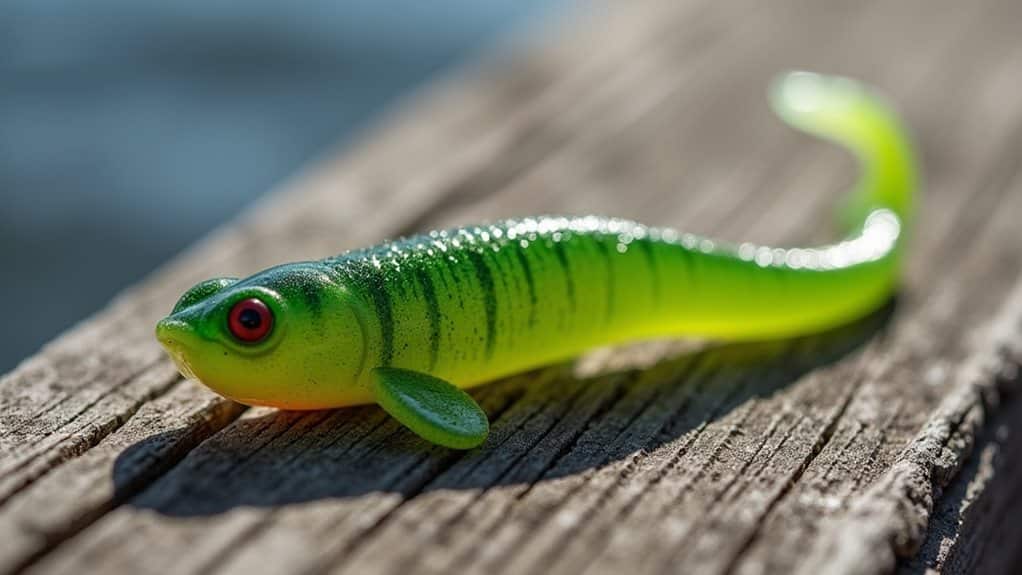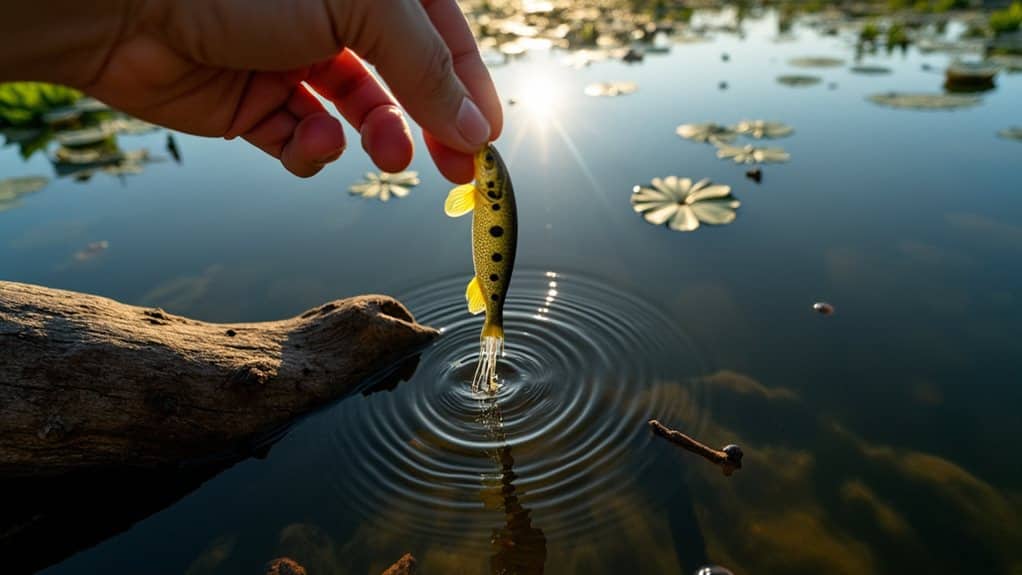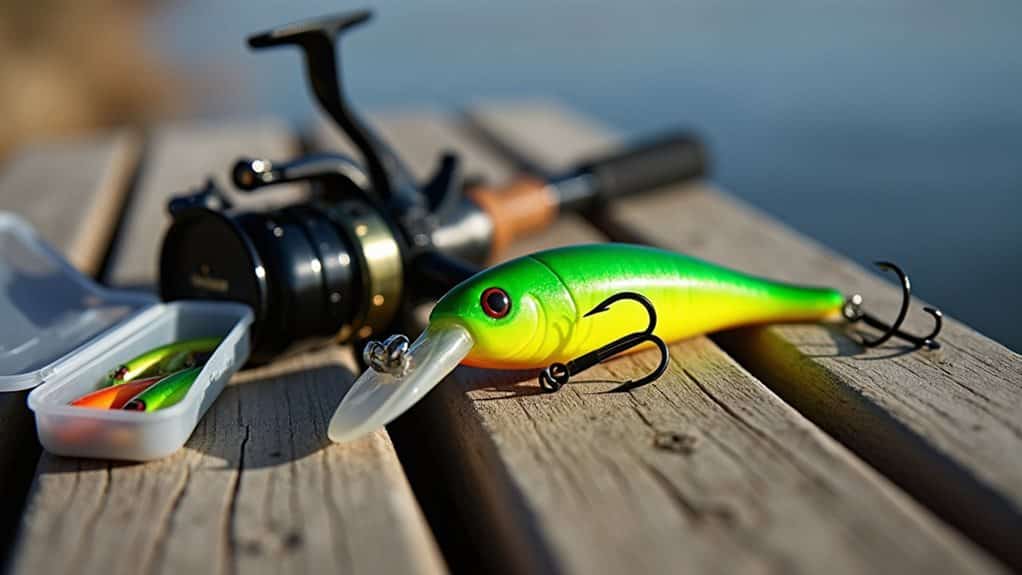To effectively fish a Senko, you’ll want to rig it either Texas-style with a bullet weight or wacky-style through the middle. Cast near structural features like docks, vegetation, or depth changes where bass gather. Let the bait fall naturally on a slack line, as most strikes occur during the descent. For best results, use green pumpkin colors in spring and adapt your retrieval speed to water conditions. Understanding the finer points of Senko fishing will enhance your success rate considerably.
TLDR
- Texas rig or wacky rig your Senko based on cover conditions, with Texas better for vegetation and wacky for open water.
- Let the Senko fall naturally on slack line, as most strikes occur during the descent phase.
- Target structure like docks, vegetation edges, and depth changes where bass naturally gather to feed.
- Choose natural colors like green pumpkin in clear water and darker colors in murky conditions.
- Fish slowly and deliberately, allowing the Senko’s subtle movements to trigger strikes from nearby bass.
Essential Senko Features and Construction

The Gary Yamamoto Fat Senko stands as a demonstration to thoughtful lure design, offering anglers a chunkier profile that builds upon the success of the original Senko model.
You’ll find this soft plastic bait crafted with flexibility and durability in mind, available in 3-, 4-, and 5-inch sizes. Similar to how direct coupling enhances performance in modern fiber optic systems, the Fat Senko’s design maximizes its effectiveness in the water. Additionally, its design allows for better strike absorption due to the lure’s plumper construction, enhancing strike absorption while maintaining the subtle, life-like action that’s made Senkos famous.
Basic Rigging Methods for Beginners
You’ll find that mastering basic Senko rigging techniques starts with two fundamental methods: the Texas rig and the wacky rig.
The Texas rig, which involves threading your hook through the Senko’s body and securing a bullet weight at the head, works perfectly for fishing in heavy cover and around structures. Using sinker stoppers can improve the bait’s fall and reduce snags. Additionally, this method is especially effective in stress relief as you focus on the repetitive action of casting and reeling.
For beginners looking to catch more fish, the wacky rig offers an incredibly effective alternative where you’ll simply hook the Senko through its middle section, creating an enticing flutter action as it falls through the water column. This technique can enhance your overall fishing experience by allowing you to enjoy the tranquility of nature while waiting for a bite.
Texas Rig Setup Steps
Setting up a Texas rig properly can mean the difference between a successful day on the water and going home empty-handed.
Start by threading your bullet weight onto the line, narrow end first, then tie on your worm hook.
Insert the hook into the nose of your Senko, push it about half an inch, then rotate it 180 degrees and reinsert it just beneath the surface.
Wacky Rig Made Simple
Getting started with a wacky rig couldn’t be simpler, making it one of the most beginner-friendly ways to catch bass.
Just thread your hook through the middle of your Senko-style worm, letting both ends hang freely. For better bait durability, you can add an O-ring in the center.
Use a drop shot or EWG hook, and you’re ready to start catching fish.
Finding the Best Spots to Cast Your Senko

When searching for prime Senko fishing spots, successful anglers focus on areas where bass naturally gather and feed.
Look for structural features like docks, bridge pilings, and vegetation zones, which provide excellent ambush points.
You’ll find the most success near depth variations, particularly drop-offs where shallow water meets deep, and around areas with active baitfish or visible surface activity. Additionally, consider using the right fishing rod and reel combo to enhance your casting accuracy and overall performance.
Proven Retrieval Techniques That Work
The three most effective retrieval techniques for your Senko will help you land more bass consistently.
Your first option is the dead stick natural fall, where you’ll let the bait sink naturally while maintaining a slack line.
The twitch and glide method involves subtle rod movements to create an erratic action that triggers strikes.
Finally, you can employ the slow roll with pauses technique, which combines a steady retrieve with strategic stops, allowing the Senko to flutter enticingly through the water column. Understanding local fishing conditions can enhance the effectiveness of these techniques and increase your chances of a successful catch.
Dead Stick Natural Fall
Becoming proficient in the dead-stick natural fall technique with a Senko can dramatically enhance your bass fishing success, especially in clear, shallow waters where visibility is ideal.
Simply cast your weightless, wacky-rigged Senko and let it fall naturally without manipulation. The bait’s natural shimmy during descent will attract nearby bass, and while it requires patience, this technique’s effectiveness makes the wait worthwhile.
Twitch and Glide Method
Becoming skilled at the twitch and glide method with a Senko can change your bass fishing success by creating an irresistible, natural presentation that triggers strikes.
You’ll want to maintain a controlled slack line while imparting subtle action with light rod twitches. This technique works especially well around structure, with both weighted and weightless setups adapting perfectly to different water depths and conditions.
Slow Roll With Pauses
Since mastering the slow roll technique with a Senko can dramatically enhance your catch rate, you’ll want to focus on maintaining a deliberate, methodical retrieve with strategic pauses.
Keep your movements smooth and steady while working the lure along the bottom, incorporating brief stops to let the bait settle naturally. This mimics injured prey and triggers the predatory instinct in nearby fish.
Seasonal Strategies for Senko Success
While Senko fishing can be productive year-round, adapting your approach to seasonal patterns will dramatically improve your success rate.
In spring, you’ll want to target rising water and flooding vegetation with nail-weighted Senkos in natural colors like green pumpkin.
Switch to wacky rigs in shallow waters under 10 feet, and don’t forget to adjust your presentation based on water temperature and clarity.
Must-Have Equipment and Line Selection

Selecting the right equipment will take your Senko fishing from good to great, and you’ll need to pair specific gear with proper techniques to maximize your success.
Start with a medium-action spinning rod around 7 feet long, paired with a quality reel like the Pflueger Supreme.
For line choice, go with 8-10 lb fluorocarbon, which offers excellent sensitivity and underwater clarity.
Final Note
You’ll find that commanding Senko fishing isn’t as complex as it might seem. By following these rigging methods, location strategies, and retrieval techniques, you’re well-equipped to start catching more fish. Remember to match your gear appropriately, adjust your approach with the seasons, and most importantly, stay patient with the presentation. Whether you’re a beginner or experienced angler, the Senko remains one of bass fishing’s most reliable and versatile tools.




